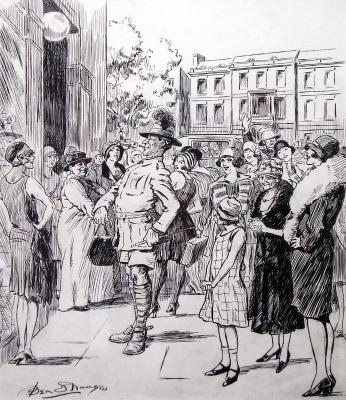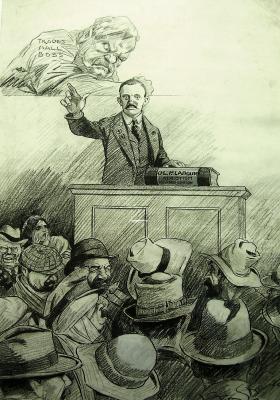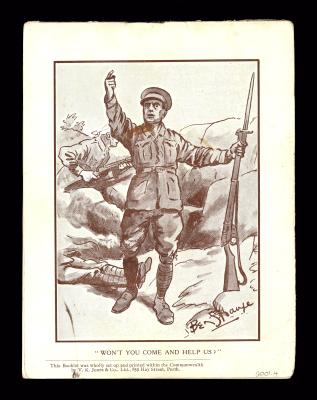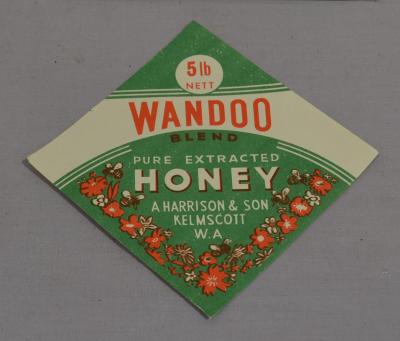CARTOON - THE GREAT PEACE POSTER
1917Scene of a caricature of American President Woodrow Wilson wearing a ballet tutu and holding a dove in each hand. He has wings on his back and is wearing white women's healed shoes. In the background is the image of 'Uncle Sam' looking on. Written above Wilson's head is the word [PEACE]
Ben Strange signature bottom right
The cartoon was published in the Western Mail on 2 February 1917 with the caption:
THE GREAT PEACE POSER.
"More Limelight Please."
Strange is continuing a common theme of his WW1 cartoons - critiquing the actions of Woodrow Wilson in his neutral stance during the war. In this cartoon it is Wilson’s role as peace mediator that is under scrutiny. Whilst advocating from the early days of the war that the USA’s neutral stance allowed the country to operate as a mediator, these efforts were even more pronounced in December 1916 and January 1917. This was a consequence of the Peace Note sent by the German Chancellor, von Bethmann-Helwegg, in December of 1916 to the US, Swiss and Spanish Ambassadors to be passed onto the Allies (see analysis of The “Waits” cartoon for more on this).
On the 22 January 1917 Wilson gave a speech to the American Senate calling for peace without victory and suggesting the establishment of a league of nations to maintain peace and justice once the war was over. The speech echoed letters sent by Wilson to the European warring nations in December 1916, asking the warring countries to outline their war aims and to accept the USA as mediators. While both sides said they ‘believed in peace’, the point of dispute was the terms under which any peace would be negotiated. The Allies wanted reparations and the removal of the Central powers from countries they had annexed (Belgium etc.) while the Central powers wanted to maintain possession of countries annexed. Neither the Allies nor the Central powers accepted Wilson’s peace overtures.
It is the disapproving presence of Uncle Sam in the background, that indicates the view of Strange that Wilson is following the wrong path, with his desire to promote peace.
Details
Details
Artist's signature bottom right [Ben Strange]
HIGH
The Ben Strange cartoons are historically significant as they depict many key figures linked to the history and development of both Western Australia and Australia. Political figures who regularly appeared in his cartoon’s included John ‘Happy Jack’ Scaddan, the Premier of Western Australia from 1911 until 1916, and William ‘Billy’ Hughes, the Prime Minister of Australia from 1915 to 1923.
City of Armadale - History House
City of Armadale - History House
Other items by Ben Strange
- CARTOON - IN PRAISE OF BEAUTY
- CARTOON - TOMMY WALKER- STILL GOING STRONG
- CARTOON - HIS TROUBLE
- CARTOON - YOUR EYES HAVE TOLD ME SO
- CARTOON - SWEET SIMPLICITY UNDER THE MISTLETOE
- CARTOON - EXCUSE ME I HAVE A DEPUTATION TO MEET
- CARTOON - ADRIFT - DROPPING THE PILOT
- CARTOON - TEMPTING GOOD - A BERLIN SHOWCASE
- CARTOON - IN TROUBLED WATERS
- CARTOON - LABOUR REFORM
- CARTOON - ON A GOOD WICKET
- CARTOON - FINANCIAL RETURN
More items like this
Other items from City of Armadale - History House
- CARTOON - THE LONG TREK FROM THE NORTH
- CARTOON - THE STRANGE ADVENTURE OF LITTLE NOT WANTED
- CARTOON - THE DECIDING FACTOR
- CARTOON - KING COAL'S GROWL
- CARTOON - TRANSFUSION OF BLOOD
- CARTOON - THE PREMIERS CONFERENCE BOVRILISED: BUT THE STATES LIVES IN HOPE
- CARTOON - SHE'S COMING! - THE NEW TERROR
- CARTOON - THE ROAD TO ARMADALE
- AXE, FIREMAN'S
- SOUVENIR BOOKLET BLACKBOY CAMP
- PACKET HONEY LABELS
- COWLS OR COLLARS LOYAL ORANGE LODGE





